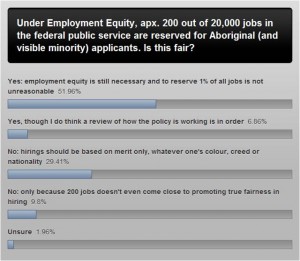Affirmative Action in Canada
Affirmative action appears in section 15.2 of the Charter of Rights.
This clause creates a positive obligation to pursue policy that betters the conditions of the disadvantaged as a principle of equality. In practice, the government has sought employment equity, particularly in public service positions. Unlike the United States Supreme Court that has strictly rejected the use of quota systems, the Canadian Supreme Court considers such a practice acceptable. (Flecher & Chalmer, 1991)
Hence, there have been spots in public service reserved for women, visible minorities and Aboriginals. A similar system exists for university admissions (Flecher & Chalmer, 1991).
Popular Reaction to Affirmative Action

Employment Equity Poll: More than 50% of survey respondents view affirmative action positively. Source: http://www.mediaindigena.com
A study done by Flecher and Chalmer (1991) showed public and governmental elite hesitancy to accept affirmative action for any group except women. When asked about affirmative action for French Canadians, only French Canadians favored the measure. Therefore, French speakers in Canada continue to consider themselves a minority.
Attitudes toward equality and merit also underlie the hesitancy to accept affirmative action. Those who value equality, as entrenched in the Charter of Rights, tend to support affirmative action while those who value merit oppose it (Flecher & Chalmer, 1991). Note that in the poll above, hosted by an indigenous blog, merit-based concerns are the second most popular option.
Racial Attitudes and Affirmative Action
Negative racial attitudes may also explain attitudes toward preference policies in Canada. A study found that racism against blacks could accurately predict attitudes towards preference policies that would improve the position of blacks at universities(Nosworthy et al, 1995).
Attitudes Toward Preference Policies in Canada
Attitudes toward preference policies in Canada are mixed at best and disapproving at worst. However, the inclusion of a positive obligation to serve disadvantaged groups in the Charter of Rights demands the implementation of affirmative action policies. It appears as though quota systems are preferred to other methods (Nosworthy et al, 1995) in order to achieve this goal. Then the question arises of how disadvantaged do Canadians feel the identified groups are? Despite the constitutional entrenchment of preference policies, public opinion does not quite accept that it fair to advantage certain groups, particularly race groups such as blacks.

